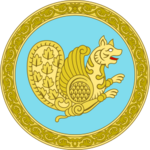House of Hazarasp
| Hazaraspid dynasty | |
|---|---|
 | |
| Country | |
| Founded | 1405 |
| Founder | Mêrxas I |
| Current head | Aram, Prince of Iotopha |
| Final ruler | Khusraw V |
| Titles | |
| Deposition | 1924: Iotophan Revolution |
The House of Hazaraspid, more formally the House of Hazarasp, was the ruling dynasty of the Kingdom of Iotopha from the 12th century to the 14th century and again from 1832 until their overthrow in 1924 during the Iotophan revolution. From the 14th century until the 19th century, dynasts primarily served as governors of Iotopha and overlords of Kajnadzor.
The Hazaraspid dynasty arrived in what in Vardana in the 12th century, believed to originate from Chuya province, near the Chu River Valley in Uluujol. Merxas I Hazarasp was the first member of the dynasty to reign over the original Kingdom of Iotopha in the 12th century. The dynasty was deposed after being integrated into the Kingdom of Vardana in the 14th century, though they remained lords of Kajnadzor and retained many of their original lands. Following the Xanthi overthrow, the dynasty was re-established as Monarchs of Iotopha, and claimed the titles of the then dormant Kingdom of Varadana. The dynasty was overthrown in the 1924 revolution, where most dynasts were killed.
The head of the House of Hazarasp is Aram, Prince of Iotopha. The head of the house continues to claim all titles and dignities of the King of Vardana, though this claim is disputed by multiple claimants.
Line of succession to the Mêrxas claim
Under Hazarasp dynastic succession, the King must adhere to Vardanan Apostolic Christianity in order to hold succession rights. Females may inherit the throne, though since the 19th century have been deemed ineligible if married to "foreign princes".
Jorin, Prince of Iotopha, was the grandson of King Aram VII through the King's second eldest son, Prince Jorin Hazarasp. In his lifetime, Jorin was recognized as Crown Prince and heir to the abolished throne ahead of the line of Stepan V due the Xwedodah marriage between Princess Delal Hazaraspid and Manuel, Crown Prince of Iotopha, the former whose line is referred to as Hazarasp-Xozan.
The Legitimist line descends from Jorin, Shahzadeh of Iotopha, the grandson of King Aram VII through his second son Prince Jorin Hazaraspid. Aram, Prince of Iotopha is the president of the Crown Council of Iotopha.
King Aram VII (1853–1920)
King Stepan V (1872–1924)
- Manuel, Shahzadeh of Iotopha (1900–1924)
- Delal, Shahdokht of Iotopha (1898–1982)
- Prince Jorin Hazarasp (1873–1919)
- Jorin, Crown Prince of Iotopha (1904–1966)
- (1) Aram, Prince of Iotopha (born 1944)
- (2) Prince Jorin Hazarasp (born 1965)
- (3) Prince Alexander Hazarasp (born 1987)
- (4) Princess Delal Hazarasp (born 1991)
- Sophia Hazarasp (born 2015) I
- Princess Elena of Dakmoor (born 2017) M
- (6) Alaia, Queen of Jehenna (born 1994)
- Mirza, Crown Prince of Jehenna (born 2015) C
- Prince Ardalan of Jehenna (born 2018) M
- (7) Prince Lashkari Hazarasp (born 1965)
- (8) Princess Sarya Hazarasp (born 1985)
- (2) Prince Jorin Hazarasp (born 1965)
- Prince Diyar Hazarasp (1946–1986)
- Prince Khusraw Hazarasp (1963–1986)
- (9) Ashti, Countess of Gueldiers (born 1969)
- Albert, Viscout of Saint-Quentin (born 1995)
- Charles de Villeneuve (born 2000)
- Athénaïs de Villeneuve (born 1997)
- Princess Alvart Hazarasp (1942–2000)
- (10) Meywan Sakar (born 1966)
- (11) Loren Sakar (born 1963)
- (12) Hormuzd Zik (born 1984)
- (13) Loren, Queen Mother of Arrautsa (born 1955)
- House of Arrautsa
- (1) Aram, Prince of Iotopha (born 1944)
- Jorin, Crown Prince of Iotopha (1904–1966)
| Mark | Source for listing or note on exclusion from succession |
|---|---|
| I | This person is not eligible to succeed the throne due to illegitimacy. |
| C | This person is not eligible to succeed the throne due to religion. |